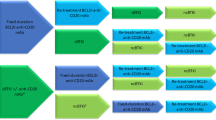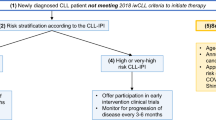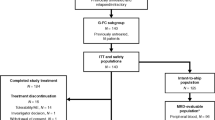Abstract
The consensus views of an expert roundtable meeting are presented as updated management guidelines for using alemtuzumab in chronic lymphocytic leukemia. Since the publication of previous management guidelines in 2004, clinical experience with alemtuzumab has grown significantly, especially regarding its efficacy and safety, management of cytomegalovirus (CMV) reactivation, identification of patient subgroups likely to benefit from alemtuzumab therapy and subcutaneous administration of alemtuzumab. The updated recommendations include (1) alemtuzumab monotherapy can be safely used as first-line therapy; (2) suitable patient subgroups for alemtuzumab therapy include elderly patients, patients with 17p deletion, patients with refractory autoimmune cytopenias and patients with profound pancytopenia at baseline due to heavily infiltrated bone marrow; (3) alemtuzumab treatment should be continued for 12 weeks (36 doses) whenever possible, and bone marrow examination may be considered at week 12 to evaluate response; (4) monitoring CMV reactivation by weekly PCR is mandated during therapy; when CMV reactivation becomes symptomatic or viremia increases, alemtuzumab therapy should be interrupted and anti-CMV therapy started; (5) subcutaneous administration is safe, easy to perform and appears equally effective compared with intravenous infusion and (6) our strong recommendation is that alemtuzumab combination therapy and consolidation therapy shall not be used outside carefully controlled clinical studies.
This is a preview of subscription content, access via your institution
Access options
Subscribe to this journal
Receive 12 print issues and online access
$259.00 per year
only $21.58 per issue
Buy this article
- Purchase on Springer Link
- Instant access to full article PDF
Prices may be subject to local taxes which are calculated during checkout

Similar content being viewed by others
References
Jemal A, Siegel R, Ward E, Hao Y, Xu J, Murray T et al. Cancer statistics, 2008. CA Cancer J Clin 2008; 58: 71–96.
Watson L, Wyld P, Catovsky D . Disease burden of chronic lymphocytic leukaemia within the European Union. Eur J Haematol 2008; 81: 253–258.
Dohner H, Stilgenbauer S, Benner A, Leupolt E, Krober A, Bullinger L et al. Genomic aberrations and survival in chronic lymphocytic leukemia. N Engl J Med 2000; 343: 1910–1916.
Catovsky D, Richards S, Matutes E, Oscier D, Dyer MJ, Bezares RF et al. Assessment of fludarabine plus cyclophosphamide for patients with chronic lymphocytic leukaemia (the LRF CLL4 Trial): a randomised controlled trial. Lancet 2007; 370: 230–239.
Thornton PD, Gruszka-Westwood AM, Hamoudi RA, Atkinson S, Kaczmarek P, Morilla RM et al. Characterisation of TP53 abnormalities in chronic lymphocytic leukaemia. Hematol J 2004; 5: 47–54.
Eichhorst BF, Busch R, Hopfinger G, Pasold R, Hensel M, Steinbrecher C et al. Fludarabine plus cyclophosphamide versus fludarabine alone in first-line therapy of younger patients with chronic lymphocytic leukemia. Blood 2006; 107: 885–891.
Flinn IW, Neuberg DS, Grever MR, Dewald GW, Bennett JM, Paietta EM et al. Phase III trial of fludarabine plus cyclophosphamide compared with fludarabine for patients with previously untreated chronic lymphocytic leukemia: US Intergroup Trial E2997. J Clin Oncol 2007; 25: 793–798.
Keating MJ, O'Brien S, Albitar M, Lerner S, Plunkett W, Giles F et al. Early results of a chemoimmunotherapy regimen of fludarabine, cyclophosphamide, and rituximab as initial therapy for chronic lymphocytic leukemia. J Clin Oncol 2005; 23: 4079–4088.
Wierda W, O'Brien S, Wen S, Faderl S, Garcia-Manero G, Thomas D et al. Chemoimmunotherapy with fludarabine, cyclophosphamide, and rituximab for relapsed and refractory chronic lymphocytic leukemia. J Clin Oncol 2005; 23: 4070–4078.
Hallek M, Fingerle-Rowson G, Fink A, Busch R, Mayer J, Hensel M et al. Immunochemotherapy with fludarabine (F), cyclophosphamide (C), and rituximab (R) (FCR) versus fludarabine and cyclophosphamide (FC) improves response rates and progression-free survival (PFS) of previously untreated patients (pts) with advanced chronic lymphocytic leukemia (CLL) (Abstract 325). Blood 2008; 112: 125.
Robak T, Moiseev SI, Dmoszynska A, Solal-Céligny P, Warzocha K, Loscertales J et al. Rituximab, fludarabine, and cyclophosphamide (R-FC) prolongs progression free survival in relapsed or refractory chronic lymphocytic leukemia (CLL) compared with FC alone: final results from the International Randomized Phase III REACH Trial (abstract). Blood 2008; 112: lba–lb1.
Byrd JC, Stilgenbauer S, Flinn IW . Chronic lymphocytic leukemia. Hematology (Am Soc Hematol Educ Program) 2004, 163–183.
Rossmann ED, Lundin J, Lenkei R, Mellstedt H, Osterborg A . Variability in B-cell antigen expression: implications for the treatment of B-cell lymphomas and leukemias with monoclonal antibodies. Hematol J 2001; 2: 300–306.
Riechmann L, Clark M, Waldmann H, Winter G . Reshaping human antibodies for therapy. Nature 1988; 332: 323–327.
Xia MQ, Hale G, Waldmann H . Efficient complement-mediated lysis of cells containing the CAMPATH-1 (CDw52) antigen. Mol Immunol 1993; 30: 1089–1096.
Mone AP, Cheney C, Banks AL, Tridandapani S, Mehter N, Guster S et al. Alemtuzumab induces caspase-independent cell death in human chronic lymphocytic leukemia cells through a lipid raft-dependent mechanism. Leukemia 2006; 20: 272–279.
Smolewski P, Szmigielska-Kaplon A, Cebula B, Jamroziak K, Rogalinska M, Kilianska Z et al. Proapoptotic activity of alemtuzumab alone and in combination with rituximab or purine nucleoside analogues in chronic lymphocytic leukemia cells. Leuk Lymphoma 2005; 46: 87–100.
Stanglmaier M, Reis S, Hallek M . Rituximab and alemtuzumab induce a nonclassic, caspase-independent apoptotic pathway in B-lymphoid cell lines and in chronic lymphocytic leukemia cells. Ann Hematol 2004; 83: 634–645.
Zent CS, Chen JB, Kurten RC, Kaushal GP, Lacy HM, Schichman SA . Alemtuzumab (CAMPATH 1H) does not kill chronic lymphocytic leukemia cells in serum free medium. Leuk Res 2004; 28: 495–507.
Zent CS, Secreto CR, Laplant BR, Bone ND, Call TG, Shanafelt TD et al. Direct and complement dependent cytotoxicity in CLL cells from patients with high-risk early-intermediate stage chronic lymphocytic leukemia (CLL) treated with alemtuzumab and rituximab. Leuk Res 2008; 32: 1849–1856.
Hillmen P, Skotnicki AB, Robak T, Jaksic B, Dmoszynska A, Wu J et al. Alemtuzumab compared with chlorambucil as first-line therapy for chronic lymphocytic leukemia. J Clin Oncol 2007; 25: 5616–5623.
Demko S, Summers J, Keegan P, Pazdur R . FDA drug approval summary: alemtuzumab as single-agent treatment for B-cell chronic lymphocytic leukemia. Oncologist 2008; 13: 167–174.
Keating M, Coutre S, Rai K, Osterborg A, Faderl S, Kennedy B et al. Management guidelines for use of alemtuzumab in B-cell chronic lymphocytic leukemia. Clin Lymphoma 2004; 4: 220–227.
Lundin J, Kimby E, Bjorkholm M, Broliden PA, Celsing F, Hjalmar V et al. Phase II trial of subcutaneous anti-CD52 monoclonal antibody alemtuzumab (Campath-1H) as first-line treatment for patients with B-cell chronic lymphocytic leukemia (B-CLL). Blood 2002; 100: 768–773.
Karlsson C, Norin S, Kimby E, Sander B, Porwit MA, Nilsson B et al. Alemtuzumab as first-line therapy for B-cell chronic lymphocytic leukemia: long-term follow-up of clinical effects, infectious complications and risk of Richter transformation. Leukemia 2006; 20: 2204–2207.
Hainsworth JD, Litchy S, Barton JH, Houston GA, Hermann RC, Bradof JE et al. Single-agent rituximab as first-line and maintenance treatment for patients with chronic lymphocytic leukemia or small lymphocytic lymphoma: a phase II trial of the Minnie Pearl Cancer Research Network. J Clin Oncol 2003; 21: 1746–1751.
Campath (alemtuzumab) prescribing information. http://www.campath.com/.March 2009.
O'Brien SM, Keating MJ, Mocarski ES . Updated guidelines on the management of cytomegalovirus reactivation in patients with chronic lymphocytic leukemia treated with alemtuzumab. Clin Lymphoma Myeloma 2006; 7: 125–130.
Osterborg A, Dyer MJ, Bunjes D, Pangalis GA, Bastion Y, Catovsky D et al. Phase II multicenter study of human CD52 antibody in previously treated chronic lymphocytic leukemia. European Study Group of CAMPATH-1H Treatment in Chronic Lymphocytic Leukemia. J Clin Oncol 1997; 15: 1567–1574.
Rawstron AC, Kennedy B, Moreton P, Dickinson AJ, Cullen MJ, Richards SJ et al. Early prediction of outcome and response to alemtuzumab therapy in chronic lymphocytic leukemia. Blood 2004; 103: 2027–2031.
Sayala HA, Moreton P, Kennedy B, Lucas G, Leach M, Rassam SMB et al. Eradication of minimal residual disease with alemtuzumab in chronic lymphocytic leukemia is associated with prolonged survival and is an appropriate therapeutic endpoint for relapsed CLL (abstract 3114). Blood 2007; 110: 916a.
Keating MJ, Flinn I, Jain V, Binet JL, Hillmen P, Byrd J et al. Therapeutic role of alemtuzumab (Campath-1H) in patients who have failed fludarabine: results of a large international study. Blood 2002; 99: 3554–3561.
Cortelezzi A, Pasquini MC, Sarina B, Bertani G, Grifoni F, Colombi M et al. A pilot study of low-dose subcutaneous alemtuzumab therapy for patients with hemotherapy-refractory chronic lymphocytic leukemia. Haematologica 2005; 90: 410–412.
Stilgenbauer S, Zenz T, Winkler D, Buhler A, Groner S, Busch R et al. Subcutaneous alemtuzumab (Campath) in fludarabine-refractory CLL: final results of the CLL2H trial of the GCLLSG and comprehensive analysis of prognostic markers (abstract 329). Blood 2008; 112: 127.
Dyer MJS, Buckby E, Fermahan P, Walewska R, Kennedy B . Increasing the dose intensity of alemtuzumab (CAMPATH-1H) in chronic lymphocytic leukemia (CLL): the CAM1515 study (abstract 2959). Blood 2005; 106: 830a.
Karlsson C, Lundin J, Kimby E, Kennedy B, Moreton P, Hillmen P et al. Phase II study of subcutaneous alemtuzumab without dose escalation in patients with advanced-stage, relapsed chronic lymphocytic leukaemia. Br J Haematol 2009; 144: 78–85.
Hwang W, Dearden C, Loh SM, Linn YC, Tien SL, Teoh G et al. Outpatient-based therapy with oral fludarabine and alemtuzumab for Asian patients with relapsed/refractory chronic lymphocytic leukemia (CLL) (abstract 4992). Blood 2006; 108: 336b.
Wierda WG, Kipps TJ, Keating MJ, Brown JR, Gribben JG, Browning ML et al. Self-administered, subcutaneous alemtuzumab to eliminate residual disease in patients with CLL (abstract 2839). Blood 2006; 108: 804a.
Elter T, Borchmann P, Schulz H, Reiser M, Trelle S, Schnell R et al. Fludarabine in combination with alemtuzumab is effective and feasible in patients with relapsed or refractory B-cell chronic lymphocytic leukemia: results of a phase II trial. J Clin Oncol 2005; 23: 7024–7031.
Montillo M, Miqueleiz S, Tedeschi A, Ricci F, Vismara E, Ciapanna D et al. Combined fludarabine, cyclophosphamide, and alemtuzumab (FCC), an active regimen for treated patients with chronic lymphocytic leukemia (abstract 3133). Blood 2007; 110: 922a.
Wierda WG, O'Brien S, Ferrajoli A, Faderl S, Koller C, Estrov Z et al. Combined cyclophosphamide, fludarabine, alemtuzumab, and rituximab (CFAR), an active frontline regimen for high-risk patients with CLL (abstract 628). Blood 2007; 110: 628a.
Wierda WG, O'Brien SM, Faderl S, Ferrajoli A, Koller C, Estrov Z et al. CFAR, an active frontline regimen for high-risk patients with CLL, including those with del 17p. (abstract 2095). Blood 2008; 112: 729.
Faderl S, Thomas DA, O'Brien S, Garcia-Manero G, Kantarjian HM, Giles FJ et al. Experience with alemtuzumab plus rituximab in patients with relapsed and refractory lymphoid malignancies. Blood 2003; 101: 3413–3415.
Frankfurt O, Hamilton E, Acharya S, Duffey S, Raji A, Rosen ST . A phase II trial of alemtuzumab and rituximab in patients with previously untreated CLL (abstract 2056). Blood 2007; 110: 612a–613a.
Zent CS, Call TG, Shanafelt TD, Tschumper RC, Jelinek DF, Bowen DA et al. Early treatment of high-risk chronic lymphocytic leukemia with alemtuzumab and rituximab. Cancer 2008; 113: 2110–2118.
Pettitt AR, Matutes E, Oscier D . Alemtuzumab in combination with high-dose methylprednisolone is a logical, feasible and highly active therapeutic regimen in chronic lymphocytic leukaemia patients with p53 defects. Leukemia 2006; 20: 1441–1445.
O'Brien SM, Kantarjian HM, Thomas DA, Cortes J, Giles FJ, Wierda WG et al. Alemtuzumab as treatment for residual disease after chemotherapy in patients with chronic lymphocytic leukemia. Cancer 2003; 98: 2657–2663.
Wierda WG, Kipps TJ, Keating MJ, Brown JR, Gribben JG, Rassenti LZ et al. Plasma alemtuzumab levels at end of treatment correlate with response and response duration in patients with CLL receiving treatment for residual disease. (abstract 2109). Blood 2008; 112: 734.
Delmer A, Leprêtre S, Cazin B, Feugier P, Tournilhac O, Leporrier M et al. Consolidation therapy with subcutaneous alemtuzumab following induction treatment with oral FC (fludarabine and cyclophosphamide) in previously untreated patients aged 65–70 years with advanced stage chronic lymphocytic leukemia: a phase II trial of the FCGCLL/MW (abstract 2831). Blood 2006; 108: 801a.
Montillo M, Tedeschi A, Miqueleiz S, Veronese S, Cairoli R, Intropido L et al. Alemtuzumab as consolidation after a response to fludarabine is effective in purging residual disease in patients with chronic lymphocytic leukemia. J Clin Oncol 2006; 24: 2337–2342.
Wendtner CM, Ritgen M, Schweighofer CD, Fingerle-Rowson G, Campe H, Jager G et al. Consolidation with alemtuzumab in patients with chronic lymphocytic leukemia (CLL) in first remission—experience on safety and efficacy within a randomized multicenter phase III trial of the German CLL Study Group (GCLLSG). Leukemia 2004; 18: 1093–1101.
Schweighofer CD, Ritgen M, Eichhorst BF, Busch R, Abenhardt W, Kneba M et al. Consolidation with alemtuzumab improves progression-free survival in patients with chronic lymphocytic leukaemia (CLL) in first remission: long-term follow-up of a randomized phase III trial of the German CLL Study Group (GCLLSG). Br J Haematol 2009; 144: 95–98.
Lin TS, Donohue KA, Lucas MS, Byrd JC, Bengston EM, Peterson BL et al. Consolidation therapy with subcutaneous alemtuzumab results in severe infectious toxicity in previously untreated CLL patients who achieve a complete response after fludarabine and rituximab induction therapy: interim safety analysis of the CALGB Study 10101 (abstract 755). Blood 2007; 110: 232a–233a.
Hainsworth JD, Vazquez ER, Spigel DR, Raefsky E, Bearden JD, Saez RA et al. Combination therapy with fludarabine and rituximab followed by alemtuzumab in the first-line treatment of patients with chronic lymphocytic leukemia or small lymphocytic lymphoma: a phase 2 trial of the Minnie Pearl Cancer Research Network. Cancer 2008; 112: 1288–1295.
Eichhorst BF, Busch R, Stauch M, Bergmann M, Ritgen M, Kranzhofer N et al. No significant clinical benefit of first line therapy with fludarabine (F) in comparison to chlorambucil (Clb) in elderly patients (pts) with advanced chronic lymphocytic leukemia (CLL): results of a phase III study of the German CLL Study Group (GCLLSG) (abstract 629). Blood 2007; 110: 194a.
Stilgenbauer S, Dohner H . Campath-1H-induced complete remission of chronic lymphocytic leukemia despite p53 gene mutation and resistance to chemotherapy. N Engl J Med 2002; 347: 452–453.
Lozanski G, Heerema NA, Flinn IW, Smith L, Harbison J, Webb J et al. Alemtuzumab is an effective therapy for chronic lymphocytic leukemia with p53 mutations and deletions. Blood 2004; 103: 3278–3281.
Osuji NC, Del GI, Matutes E, Wotherspoon AC, Dearden C, Catovsky D . The efficacy of alemtuzumab for refractory chronic lymphocytic leukemia in relation to cytogenetic abnormalities of p53. Haematologica 2005; 90: 1435–1436.
Pitini V, Arrigo C, Naro C, Buemi B, Marabello G, Santarpia M et al. Subcutaneous low-dose alemtuzumab as first line therapy for elderly CLL patients with deletion of 17p (abstract 7048). J Clin Oncol 2008; 26 (Suppl): 384s.
Barcellini W, Capalbo S, Agostinelli RM, Mauro FR, Ambrosetti A, Calori R et al. Relationship between autoimmune phenomena and disease stage and therapy in B-cell chronic lymphocytic leukemia. Haematologica 2006; 91: 1689–1692.
Karlsson C, Hansson L, Celsing F, Lundin J . Treatment of severe refractory autoimmune hemolytic anemia in B-cell chronic lymphocytic leukemia with alemtuzumab (humanized CD52 monoclonal antibody). Leukemia 2007; 21: 511–514.
Laurenti L, Tarnani M, Efremov DG, Chiusolo P, De PL, Sica S et al. Efficacy and safety of low-dose alemtuzumab as treatment of autoimmune hemolytic anemia in pretreated B-cell chronic lymphocytic leukemia. Leukemia 2007; 21: 1819–1821.
Osterborg A, Karlsson C, Lundin J, Kimby E, Mellstedt H . Strategies in the management of alemtuzumab-related side effects. Semin Oncol 2006; 33: S29–S35.
Moreton P, Kennedy B, Lucas G, Leach M, Rassam SM, Haynes A et al. Eradication of minimal residual disease in B-cell chronic lymphocytic leukemia after alemtuzumab therapy is associated with prolonged survival. J Clin Oncol 2005; 23: 2971–2979.
O'Brien S, Ravandi F, Riehl T, Wierda W, Huang X, Tarrand J et al. Valganciclovir prevents cytomegalovirus reactivation in patients receiving alemtuzumab-based therapy. Blood 2008; 111: 1816–1819.
Fiegl M, Falkner F, Falkner A, Zojer N, Fridrik M, Hopfinger G et al. Retreatment with alemtuzumab after a first, successful alemtuzumab treatment in B-CLL (abstract 4714). Blood 2007; 110: 252b.
National Comprehensive Cancer Network. Clinical Practice Guidelines in Oncology: Non-Hodgkin's Lymphoma, v.2.200. http://www.nccn.org/professionals/physician_gls/f_guidelines.asp. 2009.
Acknowledgements
We thank Wei Jiang (SciStrategy Communications) for his medical writing assistance, which was supported by Bayer Healthcare Pharmaceuticals.
Author information
Authors and Affiliations
Corresponding author
Rights and permissions
About this article
Cite this article
Österborg, A., Foà, R., Bezares, R. et al. Management guidelines for the use of alemtuzumab in chronic lymphocytic leukemia. Leukemia 23, 1980–1988 (2009). https://doi.org/10.1038/leu.2009.146
Received:
Revised:
Accepted:
Published:
Issue Date:
DOI: https://doi.org/10.1038/leu.2009.146
Keywords
This article is cited by
-
Induction of disease remission with one cycle of alemtuzumab in relapsing–remitting MS
Journal of Neurology (2018)
-
Correction to: Secondary antibody deficiency: a complication of anti-CD20 therapy for neuroinflammation
Journal of Neurology (2018)
-
Novel and emerging targeted-based cancer therapy agents and methods
Tumor Biology (2015)
-
New antibody approaches to lymphoma therapy
Journal of Hematology & Oncology (2014)
-
Alemtuzumab (anti-CD52 monoclonal antibody) as single-agent therapy in patients with relapsed/refractory chronic lymphocytic leukaemia (CLL)—a single region experience on consecutive patients
Annals of Hematology (2014)



